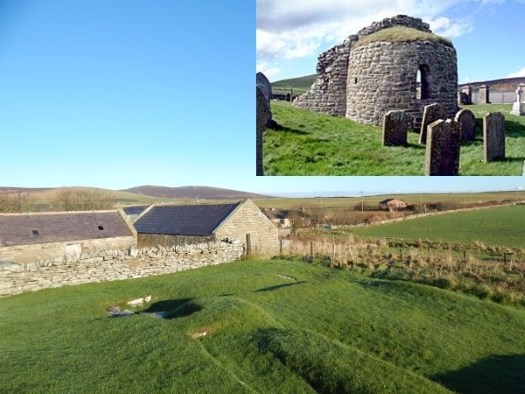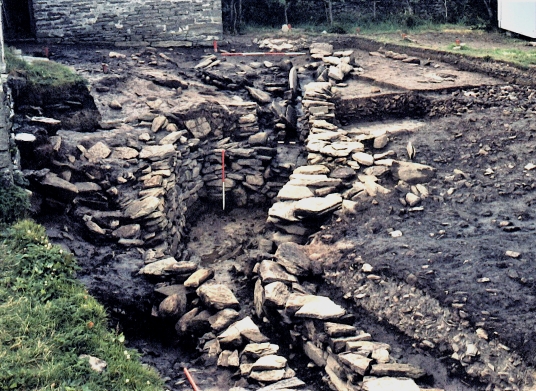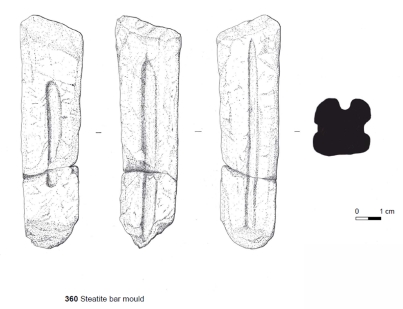Earl's Bu, Orphir, Orkney

Site
Earl's Bu, Orphir, Orkney
Author
Dr Colleen Batey, University of Glasgow
Region
Orkney Islands
Date ranges
Bronze Age and 9-12th centuries AD
Project summary
 Excavations undertaken discontinuously between 1978 and 1993 revealed a Norse period horizontal mill adjacent to the site of the Earl’s Bu and Round Church (Figure 1). Cutting through a Bronze Age burnt mound at one side and located on top of Viking period activity on another, the dry- stone construction of an underhouse, leat and lade (Figure 2) accessed a water supply north of the modern farm by a process of ponding. It had a short life, potentially only a few decades. The Viking Age deposits are rich middens dated to the 9th and early 10th century AD and include significant animal and fish bone elements in addition to a substantial collection of steatite vessel fragments. The collapse and rapid infilling of the mill structure incorporates exceptionally rich midden dumps, some of the richest examined in Orkney to date.
Excavations undertaken discontinuously between 1978 and 1993 revealed a Norse period horizontal mill adjacent to the site of the Earl’s Bu and Round Church (Figure 1). Cutting through a Bronze Age burnt mound at one side and located on top of Viking period activity on another, the dry- stone construction of an underhouse, leat and lade (Figure 2) accessed a water supply north of the modern farm by a process of ponding. It had a short life, potentially only a few decades. The Viking Age deposits are rich middens dated to the 9th and early 10th century AD and include significant animal and fish bone elements in addition to a substantial collection of steatite vessel fragments. The collapse and rapid infilling of the mill structure incorporates exceptionally rich midden dumps, some of the richest examined in Orkney to date.
 Feasting evidence supports the commentary provided in the Orkneyinga Saga, and it is clear that the Earls commanded significant resources both locally and more widely within Orkney in the Late Norse era. This was a centre of consumption in contrast the centres of production identified elsewhere – Birsay, Snusgar, and Quoygrew for example. Additional identification of bullion activity – ring money, scrap gold, ingot moulds (Figure 3) and crucibles with evidence for the working of both gold and silver -- plus two oblate sphere weights in the Baltic system, all provide a coherent indication of international contacts and integration within the wider economy at play in Late Norse Orkney. The overall site of the Earl’s Bu is considerably larger than traditionally viewed, incorporating industrial activity at Lavacroon, additional dwellings under the current Saga Centre and great complexity in the Guardianship area where grass covered foundations are visible. A Pictish symbol stone was incorporated into the later construction within the Guardianship site, but otherwise it would appear that this site is unusual in being a virgin Viking Age foundation, lacking immediate estate evidence of the Pictish/Iron Age periods.
Feasting evidence supports the commentary provided in the Orkneyinga Saga, and it is clear that the Earls commanded significant resources both locally and more widely within Orkney in the Late Norse era. This was a centre of consumption in contrast the centres of production identified elsewhere – Birsay, Snusgar, and Quoygrew for example. Additional identification of bullion activity – ring money, scrap gold, ingot moulds (Figure 3) and crucibles with evidence for the working of both gold and silver -- plus two oblate sphere weights in the Baltic system, all provide a coherent indication of international contacts and integration within the wider economy at play in Late Norse Orkney. The overall site of the Earl’s Bu is considerably larger than traditionally viewed, incorporating industrial activity at Lavacroon, additional dwellings under the current Saga Centre and great complexity in the Guardianship area where grass covered foundations are visible. A Pictish symbol stone was incorporated into the later construction within the Guardianship site, but otherwise it would appear that this site is unusual in being a virgin Viking Age foundation, lacking immediate estate evidence of the Pictish/Iron Age periods.
Keywords
Late Neolithic/Bronze Age; Norse Earldom; horizontal mill; Round Church; feasting and consumption; landscape management; bullion economy
Bibliography
Mainland, I and C E Batey 2019 (forthcoming) ‘The nature of the feast: Commensality and the politics of consumption in Viking Age and Early Medieval Northern Europe,’ World Archaeology, 51.1.
Jones, J and J Mulville 2018 ‘Norse animal husbandry in liminal environments: Stable isotope evidence from the Scottish North Atlantic islands, Environmental Archaeology 23(4): 338-351.
Mainland, I, J Towers, V Ewens, G Davis, J Montgomery, C Batey, N Card and J Downes 2016 ‘Toiling with teeth: An integrated dental analysis of sheep and cattle dentition in Iron Age and Viking-Late Norse Orkney,’ J Arch Sci: Reports 6, 837-855.
Barnes, M P and R I Page 2006 The Scandinavian Runic Inscriptions of Britain. Runrön. Runologiska bidrag utgivna as Institutionen för nordiska sprak vid Uppsala universitet, 19. Uppsala: Uppsala Universitetet.
Batey, C E 2003 ‘Excavations at the Earl’s Bu, Orphir, Orkney, c. 1859-1939’, New Orkney Antiquarian Journal 3, 29-71 .
Johnson, P G and C E Batey 2003 ‘Survey at the Earl’s Bu, Orphir, Orkney 1989-91: Geophysical work on a Late Norse estate complex. Scottish Archaeology Internet Reports, 4. https://doi.org/10.5284/1017938.
Batey, C E, J Jesch, and C D Morris (eds.) 1993 The Viking Age in Caithness, Orkney and the North Atlantic (Select Papers from the Proceedings of the Eleventh Viking Congress). Edinburgh: Edinburgh University Press.

